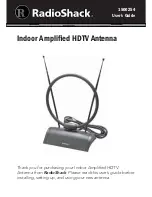
32
GROUNDING PROCEDURE FOR METAL POLE MOUNT
Remember that if you determine you want to install the optional ground rod to earth main ground, that you must call your local utility
companies and have them mark a safe spot for you to pound the ground rod into the ground near the metal pole. This will prevent you
from contacting pipes or electrical wires or cables with the ground rod.
Note: if you do not use RG6 quad shielded cable (CommScope 5781 or equivalent) you MUST use the optional method of grounding.
Do not install the ground wire on the LNB.
1. Install the pole ground clamp on the metal pole. Install it 13
inches above the soil or the concrete base.
2. Bend one end of the 8 AWG aluminum ground wire in a
1-1/2-inch loop.
3. Attach the loop to the pole ground clamp.
4. Run the wire up the pole and attach it to the radio ground
screw.
5. Use tie-wraps to hold the coaxial cable and ground wire to
the mast.
Optional or as required by local codes
6. Pick a spot on the ground near where you installed the
antenna for the ground rod installation. Call the utility com-
pany to mark the ground around the spot for buried utility
lines. Make sure that there are no underground pipes or
cables there.
7. Use a sledge hammer to drive the ground rod into the
ground at the spot marked as safe by the utility company.
Six to 10 inches of the rod should remain exposed.
8. Attach the 2-3/8-inch ground clamp about one foot from the
base of the metal pole mount.
9. Attach the ground rod clamp to the ground rod.
10. Bend one end of the 14 AWG copper ground wire in a
1-1/2-inch loop. Attach the loop to the ground clamp or
grounding lug on the metal pole and the other end of the
grounding wire to the clamp on the ground rod.
11. Bend one end of the 6 AWG copper ground wire in a 1-1/2-
inch loop. Attach the loop to the ground rod ground clamp.
Attach the other end to the building earth ground.
PARTS NEEDED
TOOLS NEEDED
• 5/8-inch x 10-foot ground rod
• Ground rod clamp
• 1/-inch x 2-3/8-inch ground clamp for pole
• Cable ties
• 8 AWG aluminum ground wire
• 14 AWG copper ground wire (optional)
• 8 AWG copper ground wire (optional)
• Adjustable wrench
• Lineman pliers
• Ladder or step ladder
• Sledge hammer
DANGER
• Failure to properly ground the satellite system may
result in severe personal injury or death.
• Do not attempt to ground the satellite system unless
you have the skills to do so in accordance with NEC
code.
CAUTION
• The National Electric Code (NEC) and local codes
require the satellite system to be grounded to the alter-
nating current main earth ground point.
• Grounding the system helps protect against damage
caused by static voltage buildup, nearby lightning
strikes, and power line crossings.
• To avoid contacting pipes or electrical wires or cables,
call your local utility companies before installing the
optional ground rod.
• Failure to ground the satellite system will void your
warranty.
Figure 41
To GND Block
RG6
GND rod
Mast
6AWG copper
To Earth Ground
14AWG Copper
8AWG Aluminum









































